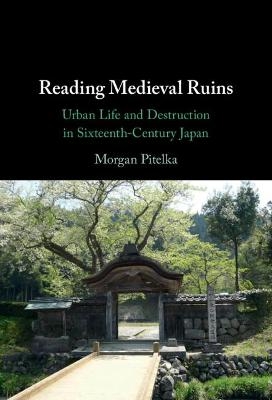
Reading Medieval Ruins
Urban Life and Destruction in Sixteenth-Century Japan
Seiten
2022
Cambridge University Press (Verlag)
978-1-316-51306-4 (ISBN)
Cambridge University Press (Verlag)
978-1-316-51306-4 (ISBN)
Drawing on rich archaeological evidence uncovered at Ichijōdani, Pitelka proposes a new understanding of late medieval Japanese society. Exploring the city's layout, residents' possessions, politics, war, religion, and cultural networks, he argues that provincial centers could be dynamic and vibrant nodes of entrepreneurship and sophistication.
The Japanese provincial city of Ichijōdani was destroyed in the civil wars of the late sixteenth century but never rebuilt. Archaeological excavations have since uncovered the most detailed late medieval urban site in the country. Drawing on analysis of specific excavated objects and decades of archaeological evidence to study daily life in Ichijōdani, Reading Medieval Ruins in Sixteenth-Century Japan illuminates the city's layout, the possessions and houses of its residents, its politics and experience of war, and religious and cultural networks. Morgan Pitelka demonstrates how provincial centers could be dynamic and vibrant nodes of industrial, cultural, economic, and political entrepreneurship and sophistication. In this study a new and vital understanding of late medieval society is revealed, one in which Ichijôdani played a central role in the vibrant age of Japan's sixteenth century.
The Japanese provincial city of Ichijōdani was destroyed in the civil wars of the late sixteenth century but never rebuilt. Archaeological excavations have since uncovered the most detailed late medieval urban site in the country. Drawing on analysis of specific excavated objects and decades of archaeological evidence to study daily life in Ichijōdani, Reading Medieval Ruins in Sixteenth-Century Japan illuminates the city's layout, the possessions and houses of its residents, its politics and experience of war, and religious and cultural networks. Morgan Pitelka demonstrates how provincial centers could be dynamic and vibrant nodes of industrial, cultural, economic, and political entrepreneurship and sophistication. In this study a new and vital understanding of late medieval society is revealed, one in which Ichijôdani played a central role in the vibrant age of Japan's sixteenth century.
Morgan Pitelka is Professor of History and Asian Studies at the University of North Carolina at Chapel Hill.
Acknowledgements; Prologue; 1. A provincial palace city as an urban space; 2. The material culture of urban life; 3. Late medieval warlords and the agglomeration of power; 4. The material foundations of faith; 5. Culture and sociability in the provinces; 6. Urban destruction in late medieval japan; Epilogue: The excavated nation on display; Bibliography; Index.
| Erscheinungsdatum | 29.03.2022 |
|---|---|
| Zusatzinfo | Worked examples or Exercises |
| Verlagsort | Cambridge |
| Sprache | englisch |
| Maße | 157 x 235 mm |
| Gewicht | 518 g |
| Themenwelt | Geschichte ► Allgemeine Geschichte ► Mittelalter |
| Geisteswissenschaften ► Geschichte ► Regional- / Ländergeschichte | |
| Sozialwissenschaften ► Soziologie | |
| ISBN-10 | 1-316-51306-8 / 1316513068 |
| ISBN-13 | 978-1-316-51306-4 / 9781316513064 |
| Zustand | Neuware |
| Informationen gemäß Produktsicherheitsverordnung (GPSR) | |
| Haben Sie eine Frage zum Produkt? |
Mehr entdecken
aus dem Bereich
aus dem Bereich
eine neue Geschichte des Mittelalters
Buch | Hardcover (2023)
C.H.Beck (Verlag)
CHF 53,20
unterwegs mit Pilgern, Rittern, Abenteurern
Buch | Hardcover (2024)
S. Fischer (Verlag)
CHF 39,20
wie das Mittelalter unsere Städte erfand
Buch | Hardcover (2024)
Propyläen Verlag
CHF 39,95


